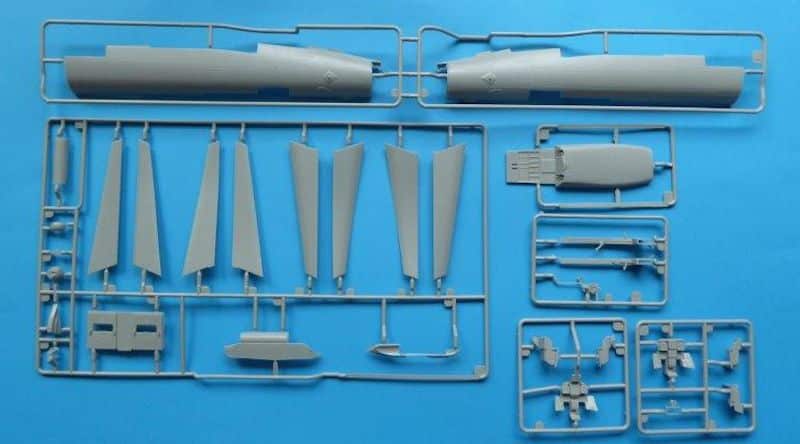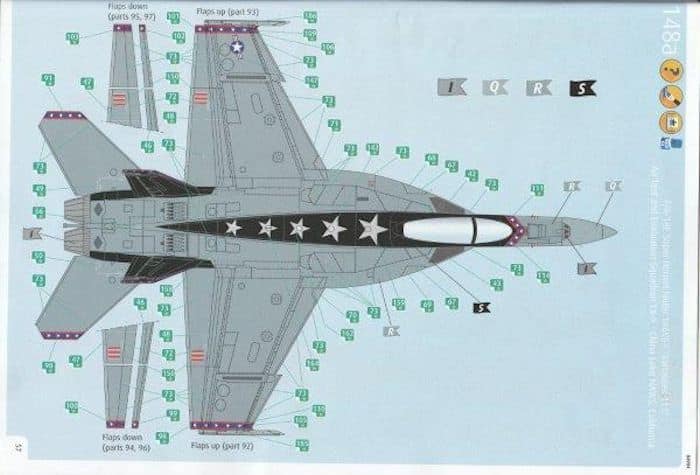Revell 1/32 F/A-18 E Super Hornet Review
Prototype: The Boeing F / A-18 E / F Super Hornet is a twin-engine, carrier-based, multi-role fighter aircraft that was primarily used by the U.S. Navy is deployed. Compared to the predecessor of the F / A-18 Hornet, it is a comprehensive new development. The airframe of the Super Hornet is much larger than that of the Hornet. The wings are 25% larger, the engines (two F414-GE-400 from General Electric) deliver 35% more thrust and the internal fuel capacity has been increased by 33%. The aim of these measures was above all to increase the range, which was the main criticism of the Hornet, as well as the landing weight since the Hornet could not land on an aircraft carrier with a full drop tank or bomb load. As a result, the operating radius of the Super Hornet could be brought back to the carrier by around 40% and up to 60% more payload (maximum 4.080 kg).>
Special distinguishing features of the Super Hornet are the diamond-shaped air inlets and the larger strakes. With the Super Hornet, the emphasis was placed on a lower radar signature. This can be seen most clearly in the new air inlets. Although the Super Hornet is a new development, 90% of the maintenance-critical parts are identical to the Hornet. The self-defense systems have been brought up to date. In the cockpit, the CRT-MFDs have been replaced by larger, colored LCDs. There is now a touchscreen under the HUD, and the analog displays for the engines and the fuel system have been replaced by two monochrome LCD screens. In addition, the ejection seat was replaced by a new model (SJU-17). All modern weapons and external navigation/target lighting pods of the Navy have been integrated and two additional weapon stations have been added. With the new JHMCS pilot helmet, the pilot can use the weapon systems more efficiently.>
The old Hornet radar, the AN / APG-73 radar, has been replaced by the much more powerful AN / APG-79. It is based on AESA technology, which compared to conventional radars has significantly better range, reliability, ECCM, and multi-target combat. The two General Electric F414-GE-400 turbofans with afterburners accelerate the Super Hornet to a top speed of Mach 1.8 at optimum altitude. The Super Hornet was originally developed by McDonnell Douglas. After these were taken over by Boeing in 1997, Boeing developed the Super Hornet up to series production and produces it to this day.
The F / A-18E was also used by the U.S. Navy introduced to replace the older F / A-18A Hornet. But the F-14 Tomcat was also removed from the U.S. Navy. Tomcat pilots who had to retrain on the Super Hornet were not very enthusiastic about it.
Now that the F / A-18C Hornet has also retired from active fleet service, the F / A-18E Super Hornet, together with the two-seater F / A-18F and the I / O-18G growler for electronic warfare, is incumbent on itself The Super Hornet the protection of the fleet. The U.S. Navy also wanted to reduce the aircraft fleet of fighter planes in order to simplify the supply of spare parts. Older F / A-18 Super Hornets from Block I have been upgraded to the Block II stand. The Super Hornet will only receive support with the introduction of the F-35C Lightning II in the next few years. The F / A-18E Super Hornet is primarily used by the U.S. Navy used with the two-seat F / A-18F having a certain export success. (Excerpts from Wikipedia)
Kit: Two years have passed since Revell announced that an F / A-18E Super Hornet in 1/32 would appear. There were a lot of problems with mold making. These have now been remedied and the first look into the huge box is very promising. Revell boxes are well known and due to their size, they could be a bit more stable. Because cardboard adorns an attractive picture of an F / A-18E of the test series VX-9 “Vampires”. Level 5 indicates that the kit, even if it only has 246 kit parts, is a bit more complex and a little experience in plastic model-making cannot hurt. 15 gray molded parts and two transparent cast frames from the basis.
Some moldings are gigantic in size and a little difficult to handle. The surface structures of the fuselage and the details of all the kit parts look very good. All engravings have been worked out very nicely. The rudder and rudder can be installed in a movable manner. Revell pays great attention to the assembly of the rear part of the fuselage. Here everything is built around the air intake shafts. An engine replica is not included in the kit. It is also not so important because why nothing would be visible anymore. Revell has worked out the turbofan blades well for this. The afterburner area is also well-detailed. The main landing gear well is reproduced very well with several built-in parts. The complete assembly of the fuselage alone devours 24 construction phases in the assembly instructions!
The chassis is extremely detailed and consists of several components. One can only hope that the main landing gear doesn’t bend under the weight of the model. The wheels included in the kit are sufficiently detailed.
The wing flaps and slats can be installed in two options. This also applies to the wingtips that can be folded up. A rich set of different external loads is included with the kit. Starting with different variants of the Sidewinder. Whereas only the AIM-9X is used today. The AIM-120C AMRAAM (2X) should not be missing either. Two laser-guided bombs of the type GBU-12 Paveway II and two GPS-controlled bombs GBU-31 JDAM and GBU 38 JDAM complete the arsenal. Not to forget the two FPU-11A additional tanks included in the kit. Only one tank is actually installed under the model fuselage. An AN-ASQ-228 ATFLIR target light container is also included. All external loads are shown in good detail and consist of several parts.
The pulpit is free of streaks and, like the original, has a slight tint. The barely visible cast burr, in the middle of the hood, needs to be removed. Otherwise, there are landing lights, position lights, and the head-up display as transparent parts.
The cockpit is sufficiently detailed and the ejection seat looks good. Personally, I would only replace the embossed seat belts with PE parts. Some detail sets are already on the market. Some components indicate that the F / A-18F and the I / O-18G will also appear. These parts are the weapons systems officer’s rear cockpit controls with the large screens. The rear-view mirrors have also been thought of.
The model of the Super Hornet can be built in the earlier Block I and later Block II variant. The assembly instructions point out the specific differences.
Building instructions/painting: I haven’t had such extensive building instructions in hand for a long time. It is a whopping 64 A-4 pages. The colored layout and colored demarcation of special features within the 151 construction phases do not present the experienced model maker with too much difficulty. The large offset-free printed decal sheet, also with extensive maintenance markings, allows the construction of two machines:
- F / A-18E Super Hornet NuBo 166957 “Vampires 111” Air Test and Evaluation VX-9- China Lake NAWS, California,
- F / A-18E Super Hornet NuBo 1666512 “Gunslingers 401” Strike Fighter Squadron VFA-105 USS Harry S Truman – 2010.
Large four-sided cracks make it easier to apply the markings. Revell refers to its own color systems such as email or aqua color. Since the hull colors have to be mixed, I would use FS (Federal Standard) colors.
Conclusion: The first impression of the kit is very promising and truly an improvement over the Trumpeter kits. Hopefully, Revell got the passport problems under control, as you had to wait a long time after the kit was first announced until it appeared in stores. Otherwise, the kit is of top quality. All components are very well-detailed. The kit price of almost 80 euros is okay here and can be described as cheap in this size. For model builders of modern U.S. Navy fighter jets highly recommended. I’m looking forward to the F / A-18F and the I / O-18G growlers.
This kit can be obtained from well-stocked specialist shops or directly from HobbyZero.com.
Literature:

















